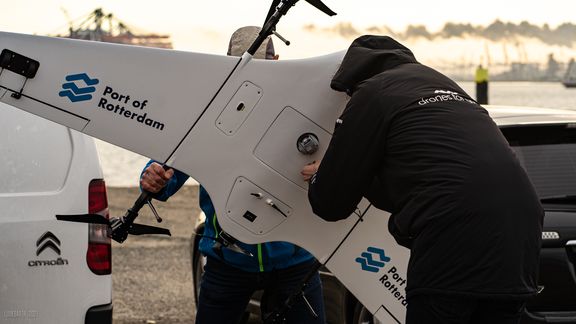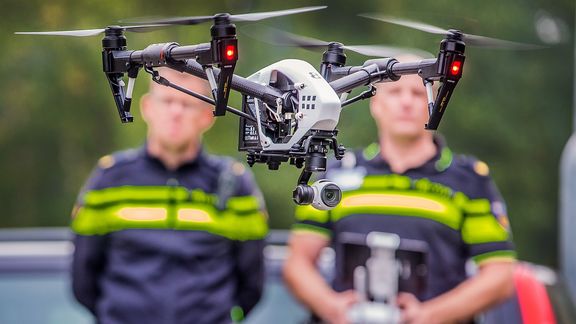
Flying in the port area
Drones may be used more widely in the future, provided safety is guaranteed. To enable wider applications, in the coming years airspace will be prepared in stages for autonomous flying, flying over cities, port and industrial areas, carrying packages and eventually unmanned flying with cargo and passengers.
The Port Authority is working with government and market parties to organise the airspace above the port in such a way that the possibilities can be used safely and quickly.
Request flight area
UAV permit holders in the specific category can use the port airspace in just a few steps. This applies to the area that we have designated as the test area for U-Space Airspace: Europoort/Maasvlakte (outside the CTR).
From 20 January 2024, flights can be requested by interfacing with the Airwayz UTM system via API/SDK, or by using the free WebApp.

Steps for using the U-Space prototype airspace
1. Operational Authorization from ILT (only in Dutch).
2. Submit a flight area at the VLL Airspace Centre of the Port of Rotterdam via the dedicated WebApp or API. Define your 4D flight area as accurately as possible.
3. Request your flight area via the WebApp preferably as early as possible, but also near real-time is possible, e.g. 2 minutes prior to the flight. Submitting flight area or trajectory requests via the API option can be done in advance or immediately before take-off. Flight authorizations are given on a first-come first-serve basis. API users have priority over WebApp users. Priority operators using API’s have priority over both.
4. When requesting the WebApp or API use for the first time, please send your Operational Authorization or LUC to the Airspace Centre. This also applies in the event of a change in the OA.
5. Cancellation of flight or flight area; if for any reason scheduled and confirmed flights are cancelled, please use the WebApp or API to notify the UTM immediately. The airspace is thus released for other users.
6. It is the responsibility of the operator to check the confirmed flight plans before taking off, since changes in the airspace may have occurred.
Services after submitting form
The area request and cancellation forms are a first step in the U-Space service; they allow operators to inform themselves of each other's presence. At the same time, we are working on software integration between operators and the Unmanned Traffic Management system which will eventually make these forms redundant.
Topicality
Please check this page regularly for changes; procedures may be adapted as we gain experience in airspace management.
Security requirements
European legislation prescribes that sites and terminals subject to ISPS (almost all sites in the port of Rotterdam) must take security measures, such as access controls. Each terminal also has appointed a PFSO (Port Facility Security Officer).
Anyone who carries out drone flights above an ISPS site must ensure that the relevant PFSO has been informed of the flights, for example by the client. A PFSO who sees an unknown drone above its premises will report it as a security incident in a port-wide application that forwards all incidents to the Seaport Police.
Open category
In the port area, drone flights are not allowed in the open category. The open category is the category not subject to licensing.
See the port area map where these areas are shown.
The zone limits are now included in most drone pre-flight apps. In time, it will become compulsory to program the drone zones into the software of unmanned aerial vehicles. The software makes it impossible for the drones to fly into a restricted zone.
Specific category
For the specific category, a permit is required. Most commercial drone applications fall into this category, which is subject to more stringent requirements such as training and certification. Providers of drone services must analyse the risks and demonstrably reduce them to an acceptable level.
Drone operators are allowed to use a drone in the port if they have received permission from the Human Environment and Transport Inspectorate (ILT), based on the risk analysis. The rules and procedures can be found on the Website of ILT.
What these rules and procedures mean for the port area and how to apply for a licence can be found in the document below.

Reporting a drone incident
There are several incidents in which a drone can be involved. What do you do in which incident?
Illegal flight
See a drone flying illegally over the port area? Call the police on 0900-8844 if you suspect an offence.
Nuisance by a drone
You can report nuisance caused by a drone to the local police at 0900-8844. They can take action in case of a violation with, or nuisance from, a drone. Is a drone flying over your property, house or residential area? Then give the police as much information as possible about the location, date and time, the drone and the pilot. If possible, take a photo or video. It is important to make a report of nuisance caused by a drone. For the police to take action. And for the government to get a better overview of incidents involving drones.
Accident or incident
If there is an acute safety risk and an urgent situation, call 112. Please note, those involved may also be subject to an obligation to make a safety report. See 'report incident for investigation'.
Report incident for investigation
Drone operators should report incidents so that the facts can be investigated;
Serious incidents and accidents (under EU 996/2010 and the National Safety Board Act) to be reported immediately to the Dutch Safety Board via telephone number 0800 6353 688.
Incidents and minor incidents (under EU 376/2014) to ILT's Aviation Incident Analysis Office; Aviation incidents | Inspectorate for the Environment and Transport (ILT) (ilent.nl)
A resilient port
Drones offer many opportunities, but they can also be used for less good purposes and involve risks around safety and security. Examples include the use of drones to take unwanted pictures of people, espionage by reading (computer) screens or other industrial espionage, preparation of criminal activities, drug crime, smuggling or possibly even terrorist intentions. We are consulting with a large number of administrative parties regarding protection against these practices in the port.
More information? Contact:
